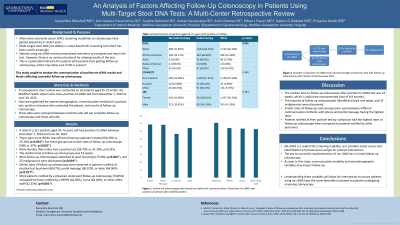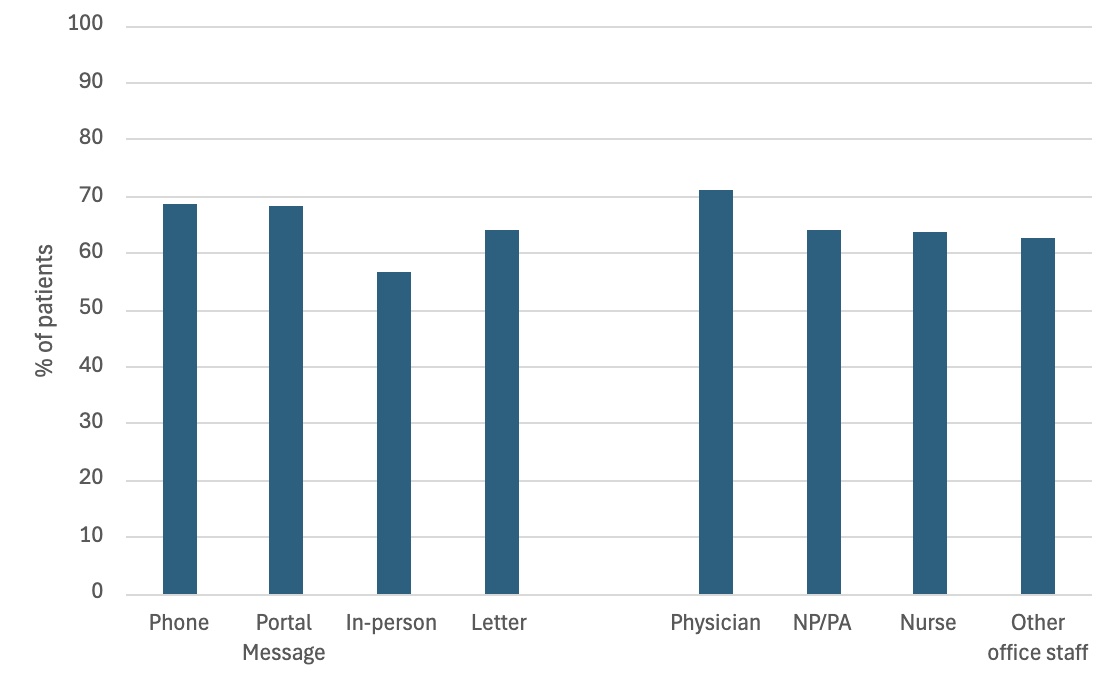Tuesday Poster Session
Category: Colorectal Cancer Prevention
P3846 - An Analysis of Factors Affecting Follow-Up Colonoscopy in Patients Using Multi-Target Stool DNA Tests: A Multi-Center Retrospective Review
Tuesday, October 29, 2024
10:30 AM - 4:00 PM ET
Location: Exhibit Hall E

Has Audio

Samantha Marshall, MD
MedStar Georgetown University Hospital
Washington, DC
Presenting Author(s)
Samantha Marshall, MD, Ann Kopera Panaccione, DO, Sophia Dahmani, BS, Advait Suvarnakar, BS, Ariel Jimenez, BS, Ethan Fraser, MD, Nadim G. Haddad, MD, Priyanka Kanth, MD
MedStar Georgetown University Hospital, Washington, DC
Introduction: Alternative colorectal cancer screening modalities to colonoscopy have gained popularity in recent years. Multi-target stool DNA (mt-sDNA) is a stool-based colorectal cancer (CRC) screening test which has been used increasingly. Patients using mt-sDNA receive protocolized reminders to complete and return the test. However, there is no universal protocol for relaying results. This is a potential hindrance for patients with positive tests getting follow-up colonoscopy, which may delay care if CRC is present. This study sought to analyze the communication of positive mt-sDNA results and factors affecting successful follow-up colonoscopy.
Methods: A retrospective chart review was conducted on all patients aged 45-75 within the MedStar Health system who had a positive mt-sDNA test from December 1, 2019 to June 30, 2023. Data were gathered for patient demographics, communication method of a positive test, position of person who contacted the patient, and results of follow-up colonoscopy. These data were compared between patients who did not complete follow-up colonoscopy and those who did.
Results: A total of 2,312 patients aged 45-75 had a positive mt-sDNA within the MedStar Health system between December 1, 2019 and June 30, 2023. There were more White than African American patients included (66.30% vs. 25.30%, p=0.001), but these groups had similar rates of follow-up colonoscopy (68% vs. 67%, p=0.001). More females than males had a positive test (58.70% vs. 41.30%, p=0.353). The median time to follow-up colonoscopy was 23 weeks. Most follow-up colonoscopies identified at least one polyp (75.90%, p< 0.001), and 25 malignancies were detected (p< 0.001). Similar rates of follow-up colonoscopy were observed in patients notified of positive test by phone (68.67%), portal message (68.32%), or letter (64.06%) (p=0.017). More patients notified by a physician underwent follow-up colonoscopy (70.85%) compared to those notified by a NP/PA (64.05%), nurse (64.43%), or other office staff (62.25%) (p=0.001).
Discussion: Mt-sDNA is a useful CRC screening modality, as it provides easier access and identification of precancerous polyps for prompt intervention. The key to successful implementation of mt-sDNA lies in timely follow-up colonoscopy. As seen in this study, communication modality and sociodemographic variables may impact follow-up. Understanding these variables will allow for intervention to ensure patients using mt-sDNA have the same favorable outcomes as patients undergoing screening colonoscopy.

Note: The table for this abstract can be viewed in the ePoster Gallery section of the ACG 2024 ePoster Site or in The American Journal of Gastroenterology's abstract supplement issue, both of which will be available starting October 27, 2024.
Disclosures:
Samantha Marshall, MD, Ann Kopera Panaccione, DO, Sophia Dahmani, BS, Advait Suvarnakar, BS, Ariel Jimenez, BS, Ethan Fraser, MD, Nadim G. Haddad, MD, Priyanka Kanth, MD. P3846 - An Analysis of Factors Affecting Follow-Up Colonoscopy in Patients Using Multi-Target Stool DNA Tests: A Multi-Center Retrospective Review, ACG 2024 Annual Scientific Meeting Abstracts. Philadelphia, PA: American College of Gastroenterology.
MedStar Georgetown University Hospital, Washington, DC
Introduction: Alternative colorectal cancer screening modalities to colonoscopy have gained popularity in recent years. Multi-target stool DNA (mt-sDNA) is a stool-based colorectal cancer (CRC) screening test which has been used increasingly. Patients using mt-sDNA receive protocolized reminders to complete and return the test. However, there is no universal protocol for relaying results. This is a potential hindrance for patients with positive tests getting follow-up colonoscopy, which may delay care if CRC is present. This study sought to analyze the communication of positive mt-sDNA results and factors affecting successful follow-up colonoscopy.
Methods: A retrospective chart review was conducted on all patients aged 45-75 within the MedStar Health system who had a positive mt-sDNA test from December 1, 2019 to June 30, 2023. Data were gathered for patient demographics, communication method of a positive test, position of person who contacted the patient, and results of follow-up colonoscopy. These data were compared between patients who did not complete follow-up colonoscopy and those who did.
Results: A total of 2,312 patients aged 45-75 had a positive mt-sDNA within the MedStar Health system between December 1, 2019 and June 30, 2023. There were more White than African American patients included (66.30% vs. 25.30%, p=0.001), but these groups had similar rates of follow-up colonoscopy (68% vs. 67%, p=0.001). More females than males had a positive test (58.70% vs. 41.30%, p=0.353). The median time to follow-up colonoscopy was 23 weeks. Most follow-up colonoscopies identified at least one polyp (75.90%, p< 0.001), and 25 malignancies were detected (p< 0.001). Similar rates of follow-up colonoscopy were observed in patients notified of positive test by phone (68.67%), portal message (68.32%), or letter (64.06%) (p=0.017). More patients notified by a physician underwent follow-up colonoscopy (70.85%) compared to those notified by a NP/PA (64.05%), nurse (64.43%), or other office staff (62.25%) (p=0.001).
Discussion: Mt-sDNA is a useful CRC screening modality, as it provides easier access and identification of precancerous polyps for prompt intervention. The key to successful implementation of mt-sDNA lies in timely follow-up colonoscopy. As seen in this study, communication modality and sociodemographic variables may impact follow-up. Understanding these variables will allow for intervention to ensure patients using mt-sDNA have the same favorable outcomes as patients undergoing screening colonoscopy.

Figure: Rates of Follow-Up Colonoscopy
Note: The table for this abstract can be viewed in the ePoster Gallery section of the ACG 2024 ePoster Site or in The American Journal of Gastroenterology's abstract supplement issue, both of which will be available starting October 27, 2024.
Disclosures:
Samantha Marshall indicated no relevant financial relationships.
Ann Kopera Panaccione indicated no relevant financial relationships.
Sophia Dahmani indicated no relevant financial relationships.
Advait Suvarnakar indicated no relevant financial relationships.
Ariel Jimenez indicated no relevant financial relationships.
Ethan Fraser indicated no relevant financial relationships.
Nadim Haddad indicated no relevant financial relationships.
Priyanka Kanth indicated no relevant financial relationships.
Samantha Marshall, MD, Ann Kopera Panaccione, DO, Sophia Dahmani, BS, Advait Suvarnakar, BS, Ariel Jimenez, BS, Ethan Fraser, MD, Nadim G. Haddad, MD, Priyanka Kanth, MD. P3846 - An Analysis of Factors Affecting Follow-Up Colonoscopy in Patients Using Multi-Target Stool DNA Tests: A Multi-Center Retrospective Review, ACG 2024 Annual Scientific Meeting Abstracts. Philadelphia, PA: American College of Gastroenterology.
